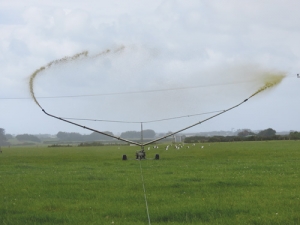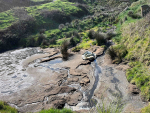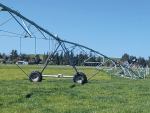The environmental effects of nitrogen that determine how much effluent you can irrigate onto land, says Waikato Regional Council.
Too much nitrogen can reduce pasture performance and reduce water quality in neighbouring waterways.
If you know eactly how much nitrogen is in effluent, you can work out the most effective application rates for your land.
In the Waikato region, no more than 150kg of nitrogen in effluent can be applied per hectare of grazed grass per year. You'll need to get effluent tested to work out how much nitrogen is going onto your land during irrigation.
Most registered analytical laboratories offer this service for around $100. When used with a nutrient budget this is a small cost compared to the fertiliser savings possible over time when effluent applications are timed efficiently.
The Overseer nutrient budget can be used to help determine how much land is needed for effluent irrigation. For more information on Overseer, click here.
How deep does each application have to be?
Each effluent application must not be more than 25mm deep. How deep you irrigate effluent over an area will depend on how much nitrogen you want to apply. Use our online calculation sheet to work out application depth, given that you know:
1. The nitrogen content of the effluent
2. How much nitrogen (kg) you want to spread per hectare.
3. Working out application rates
4. Once you've worked out the application depth, you'll need to work out the application rate for your irrigator.
Spray irrigators
1. Using the same principal as a rain gauge, mark a scale on the sides of several containers.
2. Place the containers within the area being irrigated.
3. Stop irrigating when the desired depth (maximum of 25mm) has been applied.
Other irrigators
1. To ensure you don't over-irrigate, use our online calculation sheet to work out effluent application rates for:
2. Travelling irrigators – the distance an irrigator needs to travel (in metres) per hour
3. Stationary spray 'cannons' – the length of time a spray head can stay in one place
4. Tanker systems -- the distance an irrigator needs to travel (in metres) per hour.
Ongoing irrigation management
When irrigating check for effluent ponding, particularly in areas with pugging damage. Stop ponding by avoiding irrigation in these areas, or improve the drainage by:
1. Loosening the soil in small ponding areas with a spade
2. Breaking up the soil surface, e.g. by shallow ripping.
Because effluent contains a range of nutrients, irrigated areas will need less fertiliser. Talk to your fertiliser consultant about the reduced fertiliser needs of irrigated blocks.


















